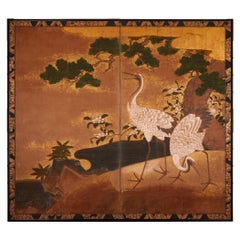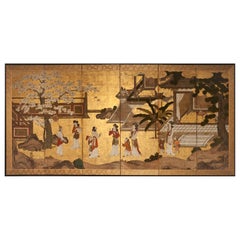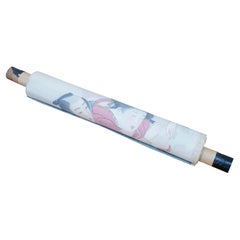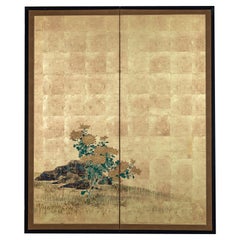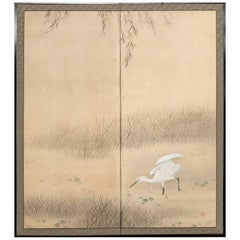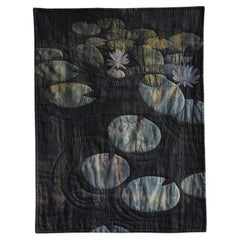Japanese Paintings and Screens
to
134
485
182
872
47
23
9
1
120
349
403
47
178
79
20
25
3
23
10
1
5
14
10
2
493
483
423
331
320
1,590
1,420
919
446
132
919
916
917
29
3
2
2
1
Place of Origin: Japanese
Japanese Two-Panel Screen: Cranes on Gold
Located in Hudson, NY
Early Kano School painting of pine trees overlooking two beautifully painted cranes and floral design in a natural setting by water’s edge. Mineral pig...
Category
Late 18th Century Antique Japanese Paintings and Screens
Materials
Gold, Gold Leaf
Japanese Six-Panel Screen Women of the Court in the Garden
Located in Hudson, NY
Japanese six-panel screen: Women of the Court in the Garden. Edo period (circa 1700) painting of an early Kano school subject matter: nobility socializing in a coutryard garden. Deta...
Category
Early 1700s Edo Antique Japanese Paintings and Screens
Materials
Gold Leaf
Vintage Japanese Ukioye Shunga Erotic Hand Painted Scoll 31"
Located in Dayton, OH
Large vintage mid 20th century ukioo-e style shunga / Japanese erotic scroll featuring six panels of amorous Kama Sutra style scenes hand painted on silk with green and gold ribbon dividers.
Shunga (春画) is a type of Japanese erotic art...
Category
Mid-20th Century Chinoiserie Japanese Paintings and Screens
Materials
Wood, Paper
$300 Sale Price
20% Off
Japanese Two Panel Screen: Simple Chrysanthemums on Gold
Located in Hudson, NY
Mineral pigments on gold leaf. Not signed, by: Baikei Hitsu.
Category
1880s Antique Japanese Paintings and Screens
Materials
Gold Leaf
Japanese Two Panel Screen, Heron In Water Lily Pond Under Willow
Located in Hudson, NY
Japanese Screen painted with Heron In Water Lily Pond Under Willow. Meiji period (1868 - 1912) painting of a heron at pond's edge. Painted in min...
Category
Early 20th Century Meiji Japanese Paintings and Screens
Materials
Wood, Paper
Suiren by Blue Tip Atelier
Located in Sammu-shi, Chiba
Title : SUIREN
Japan / 2022s
Size : W 610 H 810 mm
Expressing delicate color changes by dyeing many times.
This quilt is made with french linen and cotton.
Hand-quilted with Japanese sashiko...
Category
2010s Modern Japanese Paintings and Screens
Materials
Linen
Six Panel Japanese Screen: Winter Scene of Pine, Plum, and Bamboo
Located in Hudson, NY
Japanese Six Panel Screen: Winter Scene of Pine, Plum, and Bamboo Under Crescent Moon. Pine, plum and bamboo are known as the three friends of winter, because they all thrive and bl...
Category
Early 20th Century Taisho Japanese Paintings and Screens
Materials
Paper, Wood
Antique kimono textile art "Kobachi ~ Green Collection ~" by ikasu Green, Japan
By Kimono ikasu
Located in Setagaya City, JP
This work is inspired by the green color palette, and is framed in paulownia wood originally used for a kimono chest-of-drawers.
In this artwork, the aim was to capture the wide pal...
Category
1920s Japonisme Vintage Japanese Paintings and Screens
Materials
Silk, Wood
18th Century Japanese Two-Panel Screen Collection of Fans on Gold
Located in Hudson, NY
18th century Japanese Screen of a Collection of Fans. Paintings on fans depict famous Japanese painting subjects, this screen was most li...
Category
18th Century Edo Antique Japanese Paintings and Screens
Materials
Gold Leaf
Pair of Japanese Ink Hanging Scrolls Kano Tanyu
By Kano Tan'yu 1
Located in Atlanta, GA
A fine matching pair of hanging scrolls ink on paper mounted in green brocade borders circa Edo period (17-18th century). The Kano school painting depicts wild geese in the reeds by the margin of water, a popular subject borrowed from the Chinese tradition. Both painting were signed as Tanyu with a red seal of Morinobu, his birth name. The storage box is also present and was inscribed with the title Painting of Geese and Reeds and Kano Tanyu...
Category
Late 17th Century Japonisme Antique Japanese Paintings and Screens
Materials
Wood, Paper
$6,000 / set
Japanese 2-Panel 'Shunga' Screen with Finely Painted Erotic Depictions of Lovers
Located in Prahran, Victoria
A very finely painted two panel 'shunga' screen with scenes of naked erotic lovers in union.
The scene on the left panel simply depicts the lovers in ...
Category
Mid-20th Century Showa Japanese Paintings and Screens
Materials
Wood, Paper
Japanese Two-Panel Screen Temples Through Misty Forest
Located in Hudson, NY
Japanese two-panel screen: Temples Through Misty Forest. Chinese School landscape ink painting on gilded silk by Yukimatsu Shunpo, signed and dated 1924. Yukimatsu Shunpo was born in...
Category
1920s Taisho Vintage Japanese Paintings and Screens
Materials
Silk, Wood
Japanese Two Panel Screen: Pine on Heavy Gold
Located in Hudson, NY
Kano School painting in mineral pigments on mulberry paper with heavy gold leaf and a silk brocade border made of antique monk's robes.
Category
Late 19th Century Antique Japanese Paintings and Screens
Materials
Gold Leaf
Japanese Two Panel Screen: Craggy Landscape on Gold Sil
Located in Hudson, NY
Dramatic Mountain landscape with gnarled pines. Signature reads: Shunsen. Ink painting on gold silk with silk brocade border.
Category
Early 20th Century Japanese Paintings and Screens
Materials
Brocade, Silk
Antique obi textile art " Pine forest ~ Longivety ~ " by ikasu Green , Japan
By Kimono ikasu
Located in Setagaya City, JP
<< Story behind the work >>
Obi fabric I used for this artwork is taken from three different over 100-years-old antique sashes, and is framed in wood taken from antique chest-of-dra...
Category
Early 20th Century Japonisme Japanese Paintings and Screens
Materials
Gold Leaf
Japanese Two Panel Screen: Ikebana 'Flower Arrangement'
Located in Hudson, NY
Mineral pigment on gold silk. Signature reads: Nana Keicho Ho, Shinsho, Gachu ; Seal reads: Soju ; Seal on reverse reads: Koto Fusai.
Category
Late 19th Century Antique Japanese Paintings and Screens
Materials
Silk
Japanese Two Panel Screen: Mu (Nothing)
Located in Hudson, NY
Calligraphy reads: Mu (Nothing). Ink on silver in a black lacquered wooden trim. Seal is illegible.
Category
Early 20th Century Japanese Paintings and Screens
Materials
Silver
A Single Late 19th Century Six Panel Paper Screen, in the manner of Soga Chokuan
Located in London, GB
Six gouache painted scenes of tethered hawks, laid down to form a six panel screen, with pigment and ink on rice paper, surrounded by thickly set gold leaf border, and Japanese silk ...
Category
19th Century Edo Antique Japanese Paintings and Screens
Materials
Gold Leaf
20thc Bird Scene Based Meiji Japan 19c Artist Shiki Masaoka The Poet
Located in Amsterdam, Noord Holland
As you can see, Masaoka Nakata's brush, Shiki Masaoka, "Kakikuba", "Autumn leaves", and a bird-and-flower painting / box.
One of the representative haikus of Shiki Masaoka drawn by ...
Category
20th Century Meiji Japanese Paintings and Screens
Materials
Silk
$1,181 Sale Price
20% Off
Six panel fan-motifs screen panel (Japan)
Located in Bronx, NY
Six panel fan-motifs screen panel (Japan)
Category
19th Century Antique Japanese Paintings and Screens
$10,000 Sale Price
60% Off
Two-panel folding screen, Nihonga, Hirai Baisen (1889–1969), early Shōwa era (19
Located in PARIS, FR
Two-panel folding screen, Nihonga, Hirai Baisen (1889–1969), early Shōwa era (1940s)
This two-panel screen is signed by Hirai Baisen (1889–1969), a major Nihonga painter who is only...
Category
20th Century Japanese Paintings and Screens
Materials
Paper
Early 20th century (Meiji period) crane scroll. Original storing box
Located in Fukuoka, JP
This Meji -Taisho period painting captures a serene moment in nature, depicting graceful bird resting. Painted on silk . Signed. Includes original storage box
Size: Overall 138/...
Category
Early 20th Century Meiji Japanese Paintings and Screens
Materials
Silk, Paper
Lovely circa 1900 C-Scroll Paintings Japan Artist Signed Figures in Landscape
Located in Amsterdam, Noord Holland
Title: ???? ??????? ?? ?? ?? ?? ?? ??
Condition: State is good, thin stains.
Size Axis ... vertical 216.5cm next to 56.3cm
Painting ... vertical 126.3cm horizontal 41.5cm ? diff...
Category
20th Century Taisho Japanese Paintings and Screens
Materials
Fabric
$1,094 Sale Price
20% Off
Japanese Two Panel Screen Late Autumn Forest, Rare Obara Paper Art Screen
Located in Hudson, NY
A masterful landscape made entirely of carefully arranged mulberry paper fibers in a Japanese art practice called Obara. Accented with gold leaf. Incredible craftsmanship and a wonderful rendering of bare trees. Made by Yamauchi Issei (b. 1929), stamped in the corner. Issei is well known throughout Japan as the leading artist in Obara Paper Art. Starting in 1948, he apprenticed with Fuji Tatsukichi, a leading proponent of the arts and crafts movement in Japan who worked to Revive many cultural traditions on the brink of extinction. Issei started exhibiting in the Nitten in 1953, won the Gold Medal in 1963, and eventually became a juror. His artwork was given as a gift to the Showa Emperor of Japan, as well as dignitaries such as General Douglas MacArthur...
Category
Mid-20th Century Showa Japanese Paintings and Screens
Materials
Gold Leaf
Japanese Two Panel Screen: Seasonal Flowers
Located in Hudson, NY
Peonies, irises, lillies, paperwhites, cockscombs, thistle and other various seasonal flowers in mineral pigmnets on mulberry paper. Oxblood lacquer trim with beautiful bronze mount...
Category
Early 20th Century Japanese Paintings and Screens
Materials
Bronze
Vintage Japanese Two-Panel Screen, Taisho Period, Early 20th Century
Located in Prahran, Victoria
Japanese two-panel screen, study of an Okinawan mother and child, Taisho period early 20th century, dating from the 1920's. Signed by Matsumura Baiso, (1884-1935). Baiso was a studen...
Category
Early 20th Century Taisho Japanese Paintings and Screens
Japanese Six Panel Screen Battle of Yashima from the Heike Monogatari
Located in Hudson, NY
Yamato-e painting depicting a great land and sea battle, the Battle of Yashima, March 22, 1185. The Heike were flushed from the mountainous and prote...
Category
18th Century Antique Japanese Paintings and Screens
Materials
Gold
Blossom and Tree Scene Meiji Period Scroll Japan 19c Artist Araki Kanpo
Located in Amsterdam, Noord Holland
If it is good enough for the Japanese emperor :)
The painting's inscription says that it was painted in the artist's 82nd year, which would be 1913.
In the early Meiji Period following the Buncho ideal of hasshu kengaku ('learning eight schools'), Kanpo expanded his talents to incorporate Western painting techniques and began studying oil painting with Kawakami Togai (1827-1881) and Kunisawa Shinkuro (1847-1877). He achieved notable recognition as an oil painter and apparently was awarded the honor of painting a portrait of the Empress Dowager. Later Kanpo returned to Nihonga and continued to receive numerous honors for his work. He received a silver medal (2nd place) at the Tokyo Prefecture Crafts Competition in 1887; 2nd place with a painting of peacocks...
Category
Early 20th Century Meiji Japanese Paintings and Screens
Materials
Silk
$4,997 Sale Price
20% Off
Japanese Two Panel Screen Nara Deer in Gentle Yoshino Landscape
Located in Hudson, NY
Japanese two panel screen: Nara Deer in Gentle Yoshino Landscape. Yoshino is in the Nara Prefecture, an area famous for these small and tame deer native to J...
Category
Early 1900s Meiji Antique Japanese Paintings and Screens
Materials
Gold Leaf, Silver Leaf
Early Japanese Gohonzon Buddhist Calligraphy Mandala Scroll Edo Period
Located in Atlanta, GA
A Japanese sumi ink calligraphy Buddhist mandala mounted as a paper hanging scroll known as Kakejiku or sometimes Moji mandala. Termed as gohonzon in Japanese, it is a venerated object within Nichiren Buddhism (Hokkeshu; lotus sect). The originally concept was developed by the 13th century Buddhist priest Nichiren to guide the energy of the devotional chanting to...
Category
1810s Edo Antique Japanese Paintings and Screens
Materials
Paper
Japanese Six Panel Screen, Egrets in Water Landscape with Lotus and Loquats
Located in Hudson, NY
Hasegawa School painting in ink and gold dust accents on mulberry paper.
Category
Mid-19th Century Antique Japanese Paintings and Screens
Materials
Gold
Japanese Antiques A hanging scroll of peacock painted by Kado for Tokonoma
Located in Niiza, JP
Color on silk, Scroll head: wood
Size: Image size: 680(W) x 1600(H) [mm]
Scroll mounting: 850(W) x 2300(H) [mm]
Box size: 100(W) x 100(H) x 940(D) [mm] 1.8kg
A very well-writte...
Category
Mid-19th Century Antique Japanese Paintings and Screens
Materials
Silk
Japanese Six Panel Screen, Peonies and Young Growth on Gold Silk
Located in Hudson, NY
Rimpa floral scene. Pigment on gilded silk, signature and seal read: Hattori Shunyo. Bold colors and strong design elements combined with the trademark tarashikomi (diluted elements created when water is applied to the surface before or after pigments causing them to diffuse) exhibit the artists deep devotion to this important Japanese painting tradition. Notes about artist: Hattori Shunyo (b. 1883) was an artist from Kyoto who graduated the (now) Kyoto Municipal University of Art and fell under the circle of Yamamoto Shunkyo...
Category
Early 20th Century Japanese Paintings and Screens
Materials
Brocade, Silk
Framed Japanese Portrait of a Buddhist Priest by Goro Kamenaga
Located in Atlanta, GA
A gouache on silk painting of a Buddhist priest by Japanese painter Goro Kamenaga (1890-1955). The highly realistic painting depicts a figure in seate...
Category
1910s Meiji Vintage Japanese Paintings and Screens
Materials
Silk
S. Tosuke Signed Original Japanese Watercolor Painting of Mount Fuji Landscape
Located in Studio City, CA
A beautiful, atmospheric, and quite evocative watercolor painting of Mount Fuji towering above a small misty morning village landscape by Japanese artist/painter S. Tosuke.
The wo...
Category
1920s Taisho Vintage Japanese Paintings and Screens
Materials
Wood, Paint, Paper
Japanese Two-Panel Screen Peony and Cherry
Located in Hudson, NY
Japanese two-panel screen: Peony and Cherry, Edo period (circa 1800) painting, formerly fusuma (Japanese sliding doors), executed in the Kano school style, featuring a cherry tree in...
Category
Early 1800s Edo Antique Japanese Paintings and Screens
Materials
Gold Leaf
Pair of Japanese Six Panel Screens: Floral Landscape / Mother with Young
Located in Hudson, NY
The first screen is depicting a mother watching her young frolicking under pine tree by river's edge, the second, a mother and her young playing under a ...
Category
Late 18th Century Antique Japanese Paintings and Screens
Materials
Gold Leaf
Japanese Two-Panel Screen, Azalea Tree with Birds
Located in Hudson, NY
Beautifully painted Japanese two-panel screen with vibrant azalea tree with finches, camellia tree, and yellow azaleas. Mineral pigments and gold dust on gold silk background. Signat...
Category
Early 20th Century Japanese Paintings and Screens
Materials
Silk
Japanese Meiji Period Six-Panel Screen with Blue Lake and Flowers, Ca. 1900
Located in New York, NY
Japanese Meiji Period Six-Panel Screen with Blue Lake and Flowers, Ca. 1900
Meiji Period (1868-1912)
DIMENSIONS
Length: 145 inches
Height: 69.5 inches
Category
Early 1900s Japonisme Antique Japanese Paintings and Screens
Materials
Wood
Japanese Two-Panel Screen Peony, Wisteria, Cherry and Bamboo on Soft Silver
Located in Hudson, NY
Japanese two-panel screen: Peony, Wisteria, cherry and bamboo on soft silver, Meiji period (1868-1912) painting of a garden in spring. Painted in mineral pigments on oxidized silver ...
Category
Early 1900s Meiji Antique Japanese Paintings and Screens
Materials
Silver Leaf
Japanese Two Panel Screen Young Pine and Pine Cones on Gold
Located in Hudson, NY
Mineral pigments on gold leaf on mulberry paper with a silk brocade border.
Category
Early 1800s Antique Japanese Paintings and Screens
Materials
Brocade, Silk, Paper
Japanese Two Panel Screen: Irises Along a Raised Garden Walkway
Located in Hudson, NY
Furosaki (tea ceremony screen) Mineral pigments on mulberry paper with oxblood lacquer trim. Signature and seal read: Katsutoshi. On back it is titled: Irises (Kakitsubata) with a ...
Category
Early 20th Century Japanese Paintings and Screens
Materials
Lacquer, Paper
Antique kimono textile art " Waves and clouds ~Eternity~ " by ikasu Beige, Japan
By Kimono ikasu
Located in Setagaya City, JP
This work is inspired by traditional hand-dying technique edo-komon, and is framed in paulownia wood originally used for a kimono chest-of-drawers.
It is elegantly framed with paulo...
Category
1920s Japonisme Vintage Japanese Paintings and Screens
Materials
Silk, Wood
A Japanese painting depicting two European generals
Located in Amsterdam, NL
Nagasaki, 19th century
H. 98 x W. 41 cm
Provenance:
Private collection, Portugal
Category
19th Century Antique Japanese Paintings and Screens
Materials
Paper
Japanese Two-Panel Screen Spring Flowers
Located in Hudson, NY
A vibrant celebration of spring using a colorful ensemble of coxcomb, irises, lilies, hybiscus, and a blossoming cherry tree. Great examples of "tarashikomi" or "painting-in", a Rim...
Category
1930s Showa Vintage Japanese Paintings and Screens
Materials
Silk, Paper
Two-panel screen of " Rinpa School"
By Japanese Studio
Located in Brescia, IT
Floral scene of a Rimpa School garden with polychrome chrysanthemum flowers.
Two-panel screen painted in pigment on gilded rice paper of beautiful size and well preserved.
Bold color...
Category
20th Century Showa Japanese Paintings and Screens
Materials
Gold Leaf
Actors in Dance / Theatre Scene 20th Century Scroll Painting Japan Artist
Located in Amsterdam, Noord Holland
It is a work of 2 scrolls figure in a Theatre/Dance Noh style.
it is a very tasty work combined with the hymns spelled at the top.
¦ Silk books and handwriting.
¦ State
There ...
Category
Early 20th Century Taisho Japanese Paintings and Screens
Materials
Silk
$2,046 Sale Price
20% Off
Large C19th Japanese Silk & Bamboo Screen or Room Divider
Located in London, GB
Large C19th Japanese silk and bamboo screen.
A truly superb four-fold room divider with silk panels depicting a forest scene with birds and flowers. Each panel features a bamboo cro...
Category
Late 19th Century Japonisme Antique Japanese Paintings and Screens
Materials
Silk, Bamboo
Japanese Two Panel Screen, Ink Landscape on Paper with Gold Dust
Located in Hudson, NY
Sesshu-style painting in ink on mulberry paper with gold dust accents and a silk brocade border.
Category
19th Century Antique Japanese Paintings and Screens
Materials
Gold
Set of Four Sliding Doors (Fusuma): Wild Grasses
Located in Hudson, NY
Meiji period (1868 - 1912) four separate sliding doors (fusuma) with Shijo School paintings of wild grasses. Can be hung separately, or together as shown. Signature reads: Kogetsu....
Category
20th Century Japanese Paintings and Screens
Materials
Bronze
Artists Norikuni Kawamura, Showa Period Scroll Japan 20c Artist Nihonga
Located in Amsterdam, Noord Holland
As you can see, it is a double box and a box with "Shokakuzu" written by Norikuni Kawamura.
The
"Shokaku-zu", which is composed of graceful textures, spreads its wings and flies, i...
Category
20th Century Showa Japanese Paintings and Screens
Materials
Silk
$1,132 Sale Price
20% Off
Japanese Two Panel Screen: Horse Roundup
Located in Hudson, NY
Interesting and unusual subject matter, Tosa School painting in mineral pigments on gold leaf with silk brocade border.
Category
Late 17th Century Antique Japanese Paintings and Screens
Materials
Gold Leaf
Japanese Two Panel Screen Nihonga Style Painting of Children in Western Dress
Located in Hudson, NY
Beautiful soft painting of mineral pigments and ink on paper with a silk brocade border.
Category
Early 20th Century Japanese Paintings and Screens
Materials
Brocade, Silk, Paper
Pair of Japanese Framed Scrolls with Lotus, White Heron and Duck Decoration
Located in Stamford, CT
Pair of 19th century Japanese scrolls in frames with lotus, white heron circle of Kano Naonobu (Japan, 1607-1660) and duck beside a pond.
Category
Mid-19th Century Antique Japanese Paintings and Screens
Materials
Paper
Lovely circa 1900 C-Scroll Woodblock Japan Handcolored Buddhist 500
Located in Amsterdam, Noord Holland
A handcolored woodblock print on silk hanging
Measures: Axis ... vertical 155cm, horizontal 42cm
in ... vertical 90.5cm, horizontal 28.5cm.
Category
19th Century Meiji Antique Japanese Paintings and Screens
Materials
Fabric
$1,094 Sale Price
20% Off
An old couple (in Venice) by Blue Tip Atelier
Located in Sammu-shi, Chiba
Title : An old couple (in Venice)
Japan / 2024s
Size : w1960 x h2000 mm
While traveling in Venice, I came across an elderly couple sitting on a bench and was so inspired by their...
Category
2010s Modern Japanese Paintings and Screens
Materials
Linen
Japanese Asian Edo Period Signed Framed Hand Painted Serpent Scroll Painting
Located in Studio City, CA
A beautiful and striking framed Japanese/ Asian serpent/snake scroll painting featuring two serpents/snakes in a garden landscape surrounded by blossoming ...
Category
18th Century Antique Japanese Paintings and Screens
Materials
Wood, Paint, Paper
Lavish 19th Century Maruyama School Peacock Screen
Located in Fukuoka, JP
Lavish 19th Century Maruyama School Peacock Screen
Period: 19th Century
Size: 360 x 173 cm (141.7 x 68.1 inches)
SKU: PF12
Behold the grandeur of the ...
Category
19th Century Edo Antique Japanese Paintings and Screens
Materials
Wood, Paper
Japanese Four-Panel Screen, Young Bamboo and Morning Glory
Located in Hudson, NY
Mineral pigments on gold, signature reads: Okyo.
Category
Early 20th Century Japanese Paintings and Screens
Japanese Rare Antique Scroll of Waka Heart Poem Famous Rengetsu Otagaki, signed
Located in South Burlington, VT
Japan, a rare paper scroll hand painted by renown Rengetsu Otagaki (1791-1875). She was a very famous nun in old Japan and being familiar with poetry, her Waka poems on paper, and e...
Category
Late 19th Century Edo Antique Japanese Paintings and Screens
Materials
Paper
$1,600 Sale Price
20% Off
Recently Viewed
View AllMore Ways To Browse
Lattice Panel Wood
Hanging Japanese Screen
Japanese Lattice
Japanese 19th Century Meiji Period Silk Painting
Japanese Buddhist Screen
Japanese Carved Screen
Japanese Screens And Doors
Japanese Autumn Screen
Japanese Screens Six Fold
Japanese Wood Room Divider
Kyoto Silk Painting
Japanese Dragon Painting
Japanese Birds Painted On Silk
Heian Period
Japanese Crane Panel
Japanese Divider Screen
Japanese Pheasant
Japanese Screen Chrysanthemums
